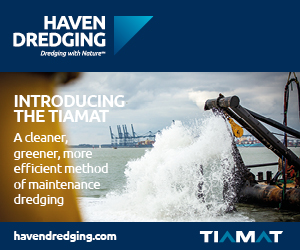
18 minute read
America's Engineers: The People, Programs, and Projects of the U.S. Army Corps of Engineers
BY CRAIG COLLINS
The Texas Gulf Coast is one of the nation’s liveliest and most productive economic regions: Every year, about 600 million tons of cargo move through ports from Orange to Port Isabel, generating about $250 billion in trade. A quarter of all Texans – about 7.3 million people – live along the state’s 367-mile coast.
The region is also, for several reasons – subsidence, sea level rise, and storm surges driven by powerful hurricanes and tropical storms – su ffering one of the highest rates of land loss of any coastal area in the United States. According to the Texas General Land O ffice (GLO), “Sixty-four percent of the Texas coast is eroding at an average rate of about 6 feet per year, with some locations losing more than 30 feet per year.”
The GLO is one of the many partners the U.S. Army Corps of Engineers (USACE) Galveston District has been working with to study and design an ambitious and cost-effective solution to the many problems associated with these losses: Risks to public health and economies; ecosystem damage; and weakened coastal defenses against storms and erosion. The six-year effort involved experts from other countries and cities experiencing similar erosion and flooding issues – and in the Texas Gulf, a new era in flood risk reduction is about to begin, with projects from Galveston Bay to South Padre Island deploying multiple lines of defense, including structures such as seawalls, breakwaters, gates, pumping stations, and reefs.

But these lines of defense will also include an unprecedented number of projects aimed at restoring and replenishing the natural elements that have long served to soften the impacts brought by tides, waves, and storms: barrier islands, wetlands, dunes, and beaches. The material used in these restoration projects will be drawn from the roughly 30 to 40 million cubic yards of sediments USACE’s Galveston District periodically dredges from more than 1,000 miles of navigable channels and 29 ports. Once the project is funded, at a cost of just over $34 billion, the Corps of Engineers and its partners will dramatically reduce erosion and flood damage to critical infrastructure while restoring more than 6,600 acres of habitat.
Building on a Legacy
This hybrid approach to project design, combining elements of natural and engineered systems, isn’t new to USACE. For decades, they’ve been combining their beneficial dredging operations with e fforts to restore or create islands that provide wildlife habitat and recreation opportunities, while reducing coastal storm and flood risks. Since 1978, the New Orleans District has used dredged material from the Mississippi River to create and maintain more than 1,000 acres of coastal habitat – wetlands and islands – in the Baptiste Collette Bayou navigation channel.
In USACE’s Savannah District, where Dr. Jeffrey King began his USACE career as an environmental engineer and project manager in 2004, he saw up close the important role played by natural wetlands and barrier islands in protecting the Georgia coast from floods and erosion. When Hurricane Katrina devastated the Louisiana coast and the city of New Orleans in August 2005, it signaled a new era of bigger, more powerful coastal storms, in which the role of these natural features would be critical in protecting coastal communities and infrastructure.

Deployed to the Gulf of Mexico in the spring of 2010 as part of the “tiger teams” sent to respond to the Deepwater Horizon oil spill, King met Dr. Todd Bridges, an environmental researcher at the U.S. Army Engineering Research and Development Center (ERDC). “It was a real opportunity to understand the issues and concerns he was talking about,” said King, “and what the Corps could do across all business lines.”

As it happened, King’s career took a short detour from there: He went to work for the National Oceanic and Atmospheric Administration (NOAA), leading its Hollings Marine Laboratory in Charleston, South Carolina, a facility dedicated to sustaining, protecting and restoring coastal ecosystems. When the slow-moving, 1,000-mile-wide Hurricane Sandy chewed up coastline and caused $70 billion in damage from Florida to New England in October 2012, it highlighted the importance of these natural features.
“What was happening within NOAA was exactly what was happening within the Corps of Engineers, and probably across all federal agencies,” King said. “We began to take another look at natural resources and these natural systems, things like wetlands and reefs and coastal islands. We knew from the literature that they had intrinsic value, that they o ffered ecosystem services. But we also knew that they could absorb a lot of the impacts associated with natural hazards and these coastal storms. The idea was becoming more and more prominent at NOAA, and likewise, Todd and his team at the Corps were seeing the value of prioritizing them.” For at least three USACE lines of business – navigation, flood risk management, and ecosystem restoration – natural and nature-based features seemed valuable.
By late 2010, Bridges and his colleagues at ERDC had codified the incorporation of natural and nature-based features in USACE projects, establishing the Engineering With Nature (EWN) initiative. “These are concepts that certainly were around prior to 2010,” King said. “But we started to see and experience more of those e ffects of climate change. And then also, looking across the Corps’ business lines, more and more data and information was coming to the forefront in terms of the value of these natural systems. That’s when all these pieces started to come together.”
King and Bridges began to talk about how NOAA, USACE, and other partners could collaborate to advance Engineering With Nature concepts and nature-based solutions. The initiative has since expanded into a multimission, multiagency, multisector e ffort with engineering and research and development components. King, who rejoined USACE as EWN’s deputy national lead in 2016, stepped into the leadership role on Bridge’s retirement in 2023.
A key feature of EWN is that it collects ideas from engineers and projects on the ground, many of them at designated “proving grounds” at USACE divisions and districts, who are testing innovative ideas both in labs and out in the field.
Principles in Practice
The Galveston District was an obvious choice to be one of the first EWN proving grounds. Another is USACE’s San Francisco District, which spans 40,000 square miles of watershed from the Klamath River headwaters, in the Oregon Cascades, to the Salinas River headwaters of San Luis Obispo County. In San Francisco Bay, where salt ponds and farms have taken a bite out of the vast marshlands that once lined its shores, the Corps of Engineers has undertaken several restoration projects: Dredged material is directly deposited in low-lying areas, revegetated with native plants that provide cover and forage for shorebirds, and restored to wetland habitat.

“We’re continuing to advance the practice,” said Julie Beagle, chief of the district’s environmental planning section. “We’re filling in big subsided areas that used to be tidal marsh, and trying to make them function as tidal marsh again.”
Engineers in the district know that as they continue to restore habitat with these direct deposits of dredged material, the sea level continues to rise, and many of the wetlands and marshes around the bay, already fragmented by development, are at risk of drowning. It’s a problem that calls for a different strategy.
“The question, for these existing marshes that are at risk of drowning and eroding,” said Beagle, “is how do you mimic the process that would have fed them in a pre-climate change world? And how do you do that in a way that can keep pace with sea level rise as the century progresses?”
One proposed solution constitutes an experimental pilot project underway at Whale’s Tail Marsh, where waves and tides have chewed a long stretch of shoreline known as Eden Landing. Here, at low tide on the bay’s eastern shore, miniature cli ffs appear where the marsh once gently sloped into the bay. Instead of depositing dredged sediments directly, USACE and its partners are experimenting with strategically placing it in the shallow waters just offshore, where hydrodynamic models indicate the tides and wind waves are most likely to do what they’ve always done: gently sweep these sediments inshore to rebuild and replenish the mudflats and marsh.

The plan for the district’s shallow-water strategic placement pilot is set: The state and federal regulatory requirements have been met; the permits are in place; and dredging is scheduled for late 2023. Once the sediments are deposited, Beagle and her colleagues will be able to track where they go, through the ingenious application of magnetic tracking technology: Sand and clay particles will be fabricated to mimic those at Eden Landing, cloaked in a magnetic coating, and painted green. Teams from ERDC, the U.S. Geological Survey, and from England will track these particles as they pass through an array of magnets and get stuck at points along the way.
The teams won’t be able to tell how much of the 100,000 cubic yards has been distributed to certain areas, Beagle said, but it will provide evidence of the area of distribution. “It will give us some answers: Did it work? Did the sediment go where we thought it was going to go?”
It sounds like an exciting, low-cost, high-benefit solution to marsh restoration – and it may well be, but Beagle cautions that the pilot is just a beginning. “It’s sort of our best bet, when we’re placing not that much material in an already really muddy bay, to try to figure out: Does this type of intervention work, or work a little bit the way we think it should? And how can we adjust the modeling e ffort or any other type of study? As with any experiment, you can’t do it once and make a judgment. You have to do it lots of times, and adjust and reiterate.”
According to King, one of the criteria for naming a district – or increasingly, an entire division – an Engineering With Nature proving ground is that they typically have stakeholders and interested parties who would like to see nature-based solutions be prioritized. “When they collaborate with the Army’s Engineer Research and Development Center,” he said, “they’re able to accelerate practice and test methods by which more Engineering With Nature technologies and features can be realized.”
But it would be a mistake, King said, to think EWN principles are only implemented within proving grounds. In Chesapeake Bay, ERDC, USACE’s Baltimore District, and partners – including NOAA, the U.S. Fish and Wildlife Service, and the Maryland Department of Natural Resources – completed a flood risk reduction project in 2019 at Swan Island, aimed at achieving multiple objectives: flood risk reduction, wildlife habitat development, and wetland restoration. “We’ve invested considerable time and effort to better understanding these island systems,” King said. The island, part of the Martin National Wildlife Refuge in Tangier Sound, has historically served as a wind, wave, and storm surge barrier for the nearby town of Ewell, Maryland – a community reachable only by boat, and dependent on two federally maintained navigation channels.

Because Swan Island had been heavily eroded over the years, it was an ideal candidate for the beneficial use of this dredged material: In 2018, the Baltimore District deposited about 60,000 cubic yards of sediment to restore the island’s footprint, anchored it with coconut fiber logs, and graded it to elevation. The island was transformed from a fragmented habitat into a 12-acre intertidal marsh and dunes area.
“The Baltimore District came back and planted vegetation on it to help accelerate its maturity,” said King. “We’ve been monitoring the island’s performance for four years now, to better understand: How is it maturing? What kind of ecosystem service benefits are being derived? And also how is this island reducing wave energy for the nearby community – creating more resilience for that community and reducing erosion? These are the kinds of studies that we’re constantly doing.”

It would also be a mistake, King cautioned, to think of EWN projects as exclusively coastal projects. For decades, USACE’s inland districts have been working to expand river floodplains throughout the Missouri and Mississippi basins, and many “gray-green” projects are reintroducing natural and nature-based features to areas where levees and other structures were built to channel floodwaters rapidly out of vulnerable areas.

This strategy doesn’t work as well in today’s drought-and-flood cycles – particularly in the West, where atmospheric rivers account for much of the precipitation and flooding. Along California’s Pajaro River, which empties into Monterey Bay, flood risk management has been a concern for more than a century, and the levee system built decades ago was constructed in the old way: Right next to the river banks, where it would absorb the full force of floodwaters. The Corps of Engineers asked Congress to authorize a rebuild in the 1960s, but that funding never arrived. After a devastating flood in 1995, the county and state agencies responsible for maintaining the levees were sued by farmers and homeowners.
The Pajaro Valley flooded in January 2023, in the middle of an intense rainy season, and several weeks later, at midnight on March 10, the 74-year-old levee protecting the town of Pajaro failed, forcing the evacuation of the entire town and surrounding communities – 8,500 people in total, many of them farmworkers who had been underserved for decades. “Not only did people lose their homes,” Beagle said, “but crop fields were flooded for months. It was devastating.”
The Corps of Engineers has the authority to begin immediate repairs to levees damaged by storms, and fixing those breaches is the San Francisco District’s highest priority, Beagle said, before the next rainy season begins. At the same time, the district continues its design of a project that will provide better long-term solutions – including nature-based solutions – for the people of the valley. The plan is to build new levees, set back farther from the banks, that will allow the river to do what rivers are supposed to do: meander a bit; deposit silt on an agricultural floodplain; recharge groundwater in a valley whose aquifers are overdrawn; provide habitat for endangered species; and, when it floods, spread out and dissipate in force before it encounters its first levee.
The design in place now, for a stretch of the river upstream from Pajaro and the adjacent town of Watsonville, will build levees out of material partially excavated during the construction of side channels and terraces. “That has wound up saving the project a lot of money,” Beagle said. Models produced by the California Flood risk on the Upper Guadalupe has been a concern for USACE and its partners since the 1980s – long before San Jose, the heart of Silicon Valley, became the nation’s 10th-largest city. Much of the adjacent land had already been purchased under a previous plan, parts of which were constructed beginning in 2007, but elements of the plan – including a long, straight secondary channel that would have increased the velocity of floodwaters in an area already notorious for flash flooding, and where endangered steelhead trout face significant challenges in making it upstream – were ultimately rejected by USACE.

“So we started it again,” said Beagle, “under this umbrella of Engineering With Nature.” The new proposal establishes several floodplain benches along the river, excavating through spaces that were parking lots and other little-used areas. “Those areas have the potential to provide a tremendous amount of riparian habitat, and to lower flood stage and velocities,” Beagle said. “In most urban river corridors, one line of trees is kind of hanging off the edge of the bank, because they’ve built right up to the edge.”
The Upper Guadalupe project provides San Jose and USACE a rare opportunity to both reduce flood risk and expand an urban riparian corridor along a 9-mile stretch of the river. Because it doesn’t rely on traditional flood-risk reduction features, such as riprap-protected banks, it is also $350 million less expensive than the previous plan. “That’s made everybody really happy,” said Beagle.
To King, this is the most salient feature of Engineering With Nature: USACE and its partners, in a single project, can achieve not only better flood protection, but also a host of other benefits – social, economic, and ecological – often for less than it would cost to design and build a traditional solution. The Corps of Engineers dredges about 200 million cubic yards of sediment from navigable waterways every year, he said. “That sediment is a resource,” he said. “We can leverage use of the sediment we generate through our navigation mission to restore or build wetlands, or even island systems. We’re integrating these additional features to reduce risks and create more value.”

Many Engineering With Nature principles were developed in cooperation with international partners – including colleagues from Rijkswaterstaat, the agency that, since 1798, has protected the Netherlands’ low-lying landforms along the North Sea coast. In September 2021, ERDC published the “International Guidelines on the Use of Natural and Nature-Based Features for Flood Risk Management,” representing the combined wisdom of more than 130 contributors and authors from more than 75 organizations around the world. ERDC is also in the process of composing the third volume of its EWN Atlas series, which showcases EWN principles and practices in action – mostly in USACE districts, but also featuring projects from all over the globe.
“The success of the Engineering With Nature program,” said King, “involves more than just the Corps of Engineers. We owe success to a great many agencies and organizations and people. We all see the opportunity to do something that will make a difference: To achieve the engineering outcomes we all need – particularly when we consider future infrastructure needs – in a way that allows us to achieve other benefits that are equally important, and desperately needed.”










